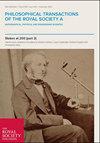行星形成理论:来自陨石研究的约束
Philosophical Transactions of the Royal Society of London. Series A, Mathematical and Physical Sciences
Pub Date : 2001-10-15
DOI:10.1098/rsta.2001.0898
引用次数: 20
摘要
球粒陨石群之间的成分变化和曾经存在于其中的短寿命核素的库存与起源于金牛座T原太阳的吸积盘一致。金牛座的爆发重新处理了流入的物质,其中一部分被回收到圆盘中。球粒陨石和迅速冷却的火成岩陨石共同构成了太阳系历史前50迈珥事件年表的基础。球粒陨石包含了太阳系形成后2兆尔内高速撞击的证据。这需要一个木星质量的物体的局部存在来提高相对速度。捕获的星际云,随后经历了引力坍缩,或一个未绑定的行星是隐含的。低倾角和高离心率的捕获会搅动吸积盘中的物质,触发小行星的形成和成长,稳定原木星的轨道,并结束原太阳的金牛座T期。本文章由计算机程序翻译,如有差异,请以英文原文为准。
Theories of planetary formation: constraints from the study of meteorites
Compositional variations between chondrite groups and the inventory of short–lived nuclides once present in them are consistent with an origin in the accretion disc of a T Tauri protosun. T Tauri outbursts reprocessed infalling matter, part of which was recycled back into the disc. Chondrites and rapidly cooled igneous meteorites together form the basis of a chronology of events over the first 50 Myr of Solar System history. Chondrites contain evidence of hypervelocity impact within 2 Myr of the formation of the Solar System. This requires the local presence of a Jupiter–massed object to pump up relative velocities. Capture of an interstellar cloudlet, which subsequently underwent gravitational collapse, or of an unbound planet is implied. Capture at a low inclination and high eccentricity would have stirred the matter in the accretion disc, triggered planetesimal formation and growth, stabilized the orbit of the proto–Jupiter, and ended the T Tauri phase of the protosun.
求助全文
通过发布文献求助,成功后即可免费获取论文全文。
去求助
来源期刊
自引率
0.00%
发文量
0

 求助内容:
求助内容: 应助结果提醒方式:
应助结果提醒方式:


